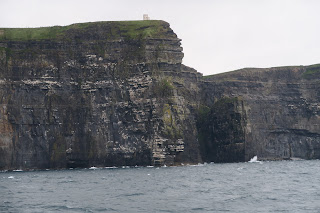The cliffs consist mainly of beds of Namurian shale and sandstone, with the oldest rocks being found at the bottom of the cliffs. During the time of their formation between 313 and 326 million years ago, a river dumped sand, silt and clay into an ancient marine basin. Over millions of years, the sediments collecting at the mouth of this ancient marine delta were compacted and lithified into the sedimentary strata preserved in the now-exposed cliffs.
Today the cliffs are subject to erosion by wave action, which undermines the base of support causing the cliff to collapse under its own weight. This process creates a variety of coastal landforms characteristics of erosional coasts such as sea caves, sea stacks, and sea stumps.
On my trip I saw the Cliffs of Moher from the bottom, on a boat, cruising from the Aran Islands back to the mainland. Unfortunately it was an overcast, slightly rainy day - so although the cliffs don’t necessarily look quite as stunning in my photos, in reality they are mighty impressive!!
Branaunmore, a 67 metre high sea stack at the foot of the Cliffs of Moher below O’Brien’s Tower was once part of the cliffs, but coastal erosion gradually removed they layers of rock that joined it with the mainland.















No comments:
Post a Comment